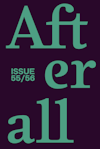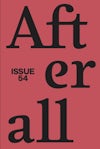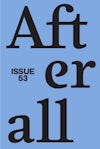
Issue 9
Spring/Summer 2004
Editors: Charles Esche, Thomas Lawson, Mark Lewis, Silke Otto-Knapp, Zoe Crosher.
Founding editors: Charles Esche, Mark Lewis.
Table of contents
Foreword
Contextual Essays
- Desperate Dreams – Thomas Lawson
- Subject Production and Political Art Practice – Marius Babias
Artists
Joan Jonas
- Get Rid of the Knots – Mark Kremer
- Joan Jonas: Images and Sounds in the Material of Time – Susan Morgan
Michael Clark
- Cross Over – Suzanne Cotter
- Let Me Entertain You – Catherine Wood
Marjetica Potr?
- Confessions of a Global Urbanist – Jan Verwoert
- Marjetica Potr?: The Politics of the Uninhabitable – Julieta González
Los Carpinteros
- Los Carpinteros: Utopian Model Makers – Jorge Reynoso Pohlenz
- Los Carpinteros Updated – Marilyn Zeitlin
Thomas Hirschhorn
- Reading Hirschhorn: A Problem of (His) Knowledge, or Weakness as a Virtue – Jan Estep
- Planes of Immanence, or the Form of Ideas: Notes on the (Anti-)Monuments of Thomas Hirschhorn – Simon Sheikh
Foreword
Written by Charles Esche
The word ‘performative’ haunts this issue of Afterall. Performative has two contrasting and yet not incompatible meanings here…
The word ‘performative’ haunts this issue of Afterall. Performative has two contrasting and yet not incompatible meanings here. In one context, it refers simply to the act of performing in public, or recording that action for later presentation. The body is always implicated in this meaning, sometimes in terms of an exceptional agility, at other times as a fragile mark of the universal human scale against which to measure abstract notions such as society, history or pleasure. Art and its critics are relatively happy with this use of the word. It describes what art does most obviously, capturing an immanent and fleeting quality and articulating its ambitions in terms of an individual protagonist.
The second potential context for ‘performative’ is taken less from cultural discourse than from administration, though the two have been inseperable since Adorno’s Culture and Administration. In this second sense, the word is associated not with action in the present but with the possibility of an effective outcome as a result of an activity already carried out. Under its administrative charge, we are asked to consider what function art might perform, and how that might be measured. In these terms, art’s performativity could be judged by what happens as a consequence of its appearance. It seems that this second understanding is brought to bear most often on art that directly approaches questions of social distress or marginalisation through the actions or materials used by the subjects of the work. The critic of such projects might ask ‘do things get “better” for the people engaged or depicted in the work?’, and provide a considered, though unquestionably subjective, opinion. What is at stake here is a judgement of the recipient or critic rather than a description of an artistic manoeuvre. That judgement then determines to a large degree the success or failure of the artwork itself.
Purchase
The publication is available for purchase. If you would like specific articles only, it is also available individually and to be downloaded as PDFs.
Purchase full publication
Buy via University of Chicago Press
Buy via Central Books
Purchase individual articles
Buy via University of Chicago Press



